Public Administration: Bureaucracy, USA, and Germany Analysis
VerifiedAdded on 2022/12/05
|17
|3823
|134
Essay
AI Summary
This essay, prepared for a Sociology 16 course, delves into the complexities of public administration, beginning with Max Weber's 'ideal type' bureaucracy and its relevance in contemporary contexts. It explores the evolution of bureaucratic frameworks, highlighting the contributions of scholars like Monroe Berger and the impact of Weber's ideas on comparative public administration. The essay examines the core functions of bureaucracy, its structure, and its role in implementing public policies. It analyzes bureaucratic practices in the USA and Germany, considering their historical development and societal impacts. The discussion includes both structural and functional aspects of bureaucracy, emphasizing the influence of social contexts on administrative systems. Furthermore, the essay critiques the limitations of the Weberian model and the need for dynamic approaches in understanding bureaucratic change within evolving socio-political landscapes. The analysis also considers the 'pathologies' of bureaucracy and the importance of situational context in assessing its effectiveness. The essay concludes by calling for a more nuanced understanding of bureaucracy and its role in achieving societal goals.
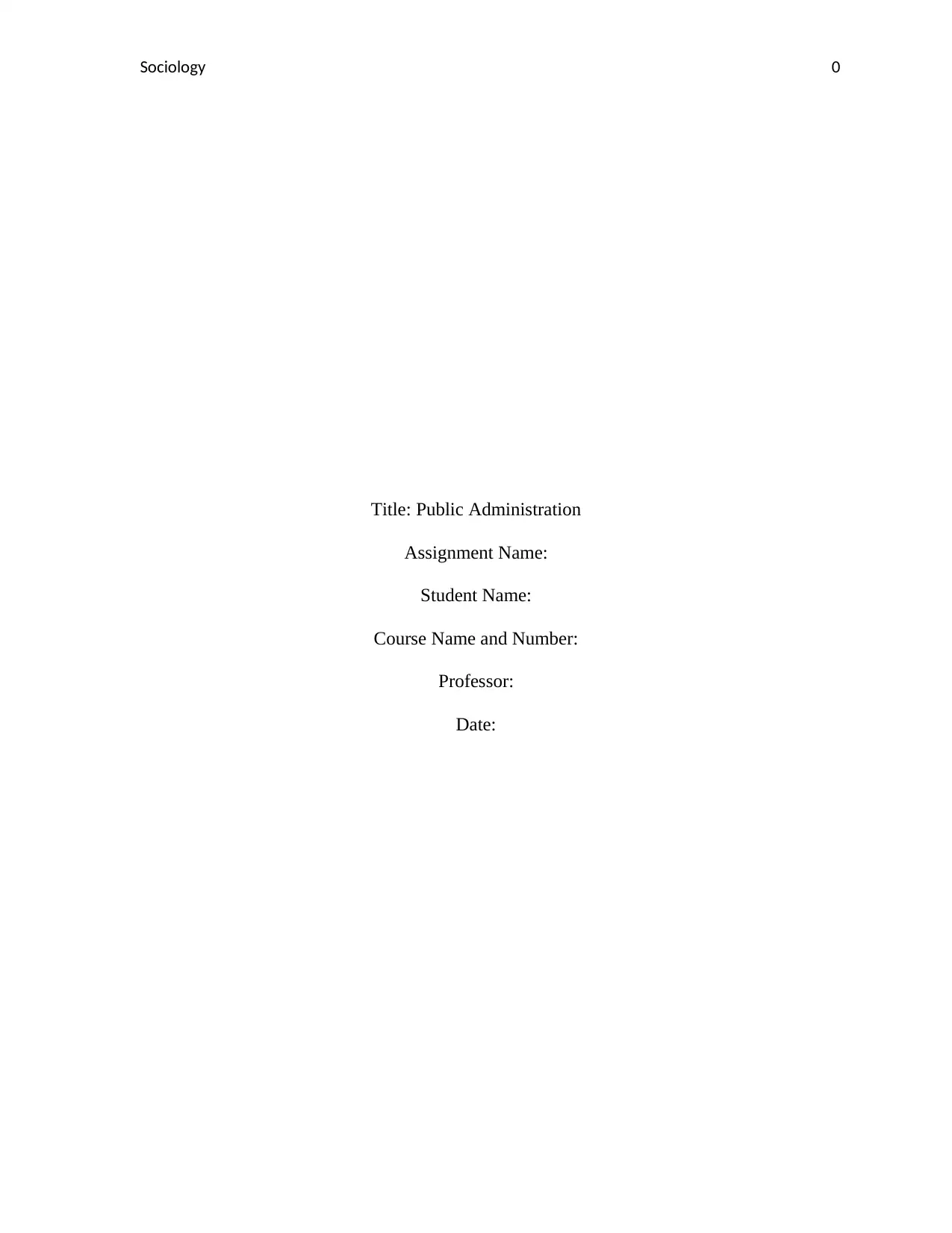
Sociology 0
Title: Public Administration
Assignment Name:
Student Name:
Course Name and Number:
Professor:
Date:
Title: Public Administration
Assignment Name:
Student Name:
Course Name and Number:
Professor:
Date:
Paraphrase This Document
Need a fresh take? Get an instant paraphrase of this document with our AI Paraphraser
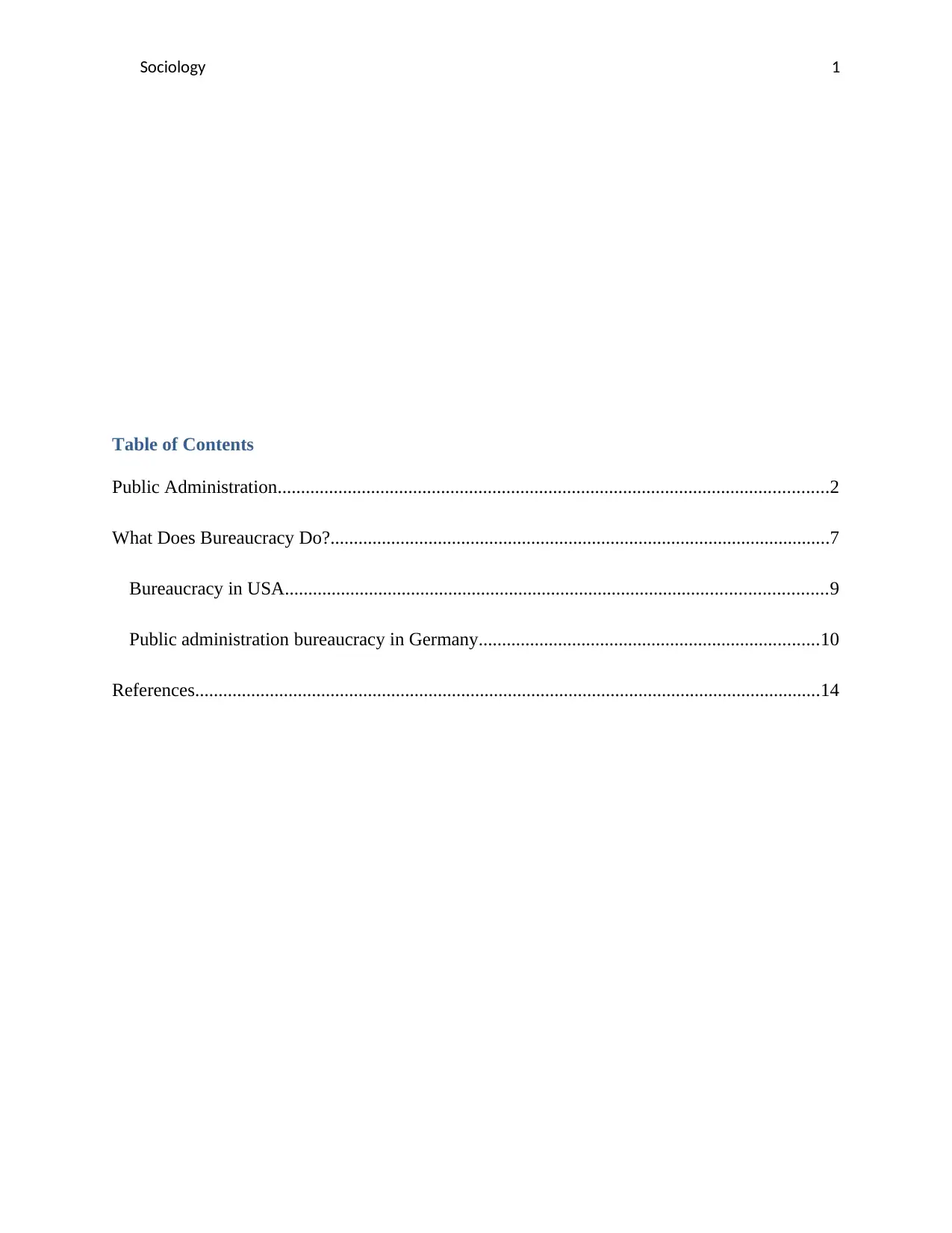
Sociology 1
Table of Contents
Public Administration......................................................................................................................2
What Does Bureaucracy Do?...........................................................................................................7
Bureaucracy in USA....................................................................................................................9
Public administration bureaucracy in Germany.........................................................................10
References......................................................................................................................................14
Table of Contents
Public Administration......................................................................................................................2
What Does Bureaucracy Do?...........................................................................................................7
Bureaucracy in USA....................................................................................................................9
Public administration bureaucracy in Germany.........................................................................10
References......................................................................................................................................14
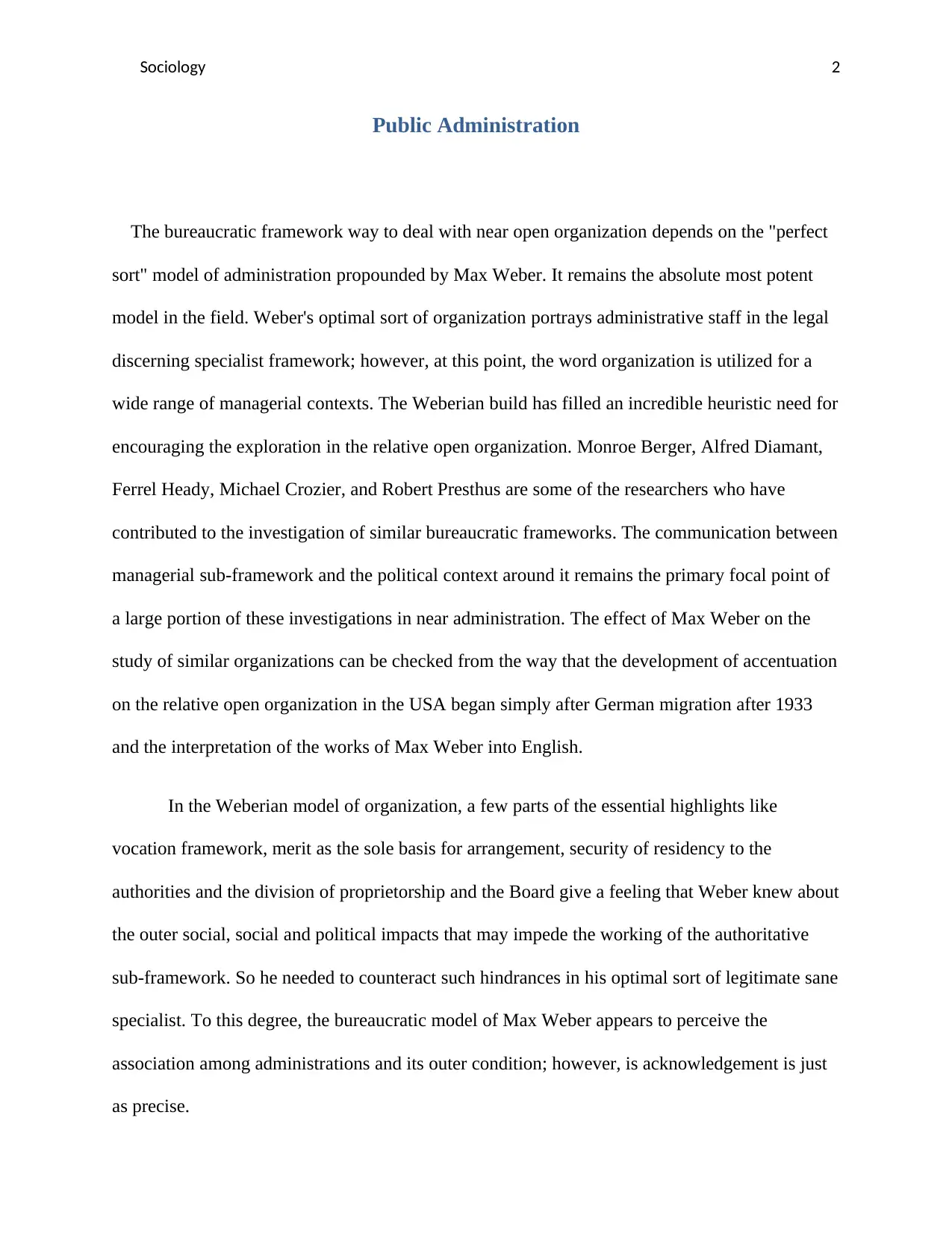
Sociology 2
Public Administration
The bureaucratic framework way to deal with near open organization depends on the "perfect
sort" model of administration propounded by Max Weber. It remains the absolute most potent
model in the field. Weber's optimal sort of organization portrays administrative staff in the legal
discerning specialist framework; however, at this point, the word organization is utilized for a
wide range of managerial contexts. The Weberian build has filled an incredible heuristic need for
encouraging the exploration in the relative open organization. Monroe Berger, Alfred Diamant,
Ferrel Heady, Michael Crozier, and Robert Presthus are some of the researchers who have
contributed to the investigation of similar bureaucratic frameworks. The communication between
managerial sub-framework and the political context around it remains the primary focal point of
a large portion of these investigations in near administration. The effect of Max Weber on the
study of similar organizations can be checked from the way that the development of accentuation
on the relative open organization in the USA began simply after German migration after 1933
and the interpretation of the works of Max Weber into English.
In the Weberian model of organization, a few parts of the essential highlights like
vocation framework, merit as the sole basis for arrangement, security of residency to the
authorities and the division of proprietorship and the Board give a feeling that Weber knew about
the outer social, social and political impacts that may impede the working of the authoritative
sub-framework. So he needed to counteract such hindrances in his optimal sort of legitimate sane
specialist. To this degree, the bureaucratic model of Max Weber appears to perceive the
association among administrations and its outer condition; however, is acknowledgement is just
as precise.
Public Administration
The bureaucratic framework way to deal with near open organization depends on the "perfect
sort" model of administration propounded by Max Weber. It remains the absolute most potent
model in the field. Weber's optimal sort of organization portrays administrative staff in the legal
discerning specialist framework; however, at this point, the word organization is utilized for a
wide range of managerial contexts. The Weberian build has filled an incredible heuristic need for
encouraging the exploration in the relative open organization. Monroe Berger, Alfred Diamant,
Ferrel Heady, Michael Crozier, and Robert Presthus are some of the researchers who have
contributed to the investigation of similar bureaucratic frameworks. The communication between
managerial sub-framework and the political context around it remains the primary focal point of
a large portion of these investigations in near administration. The effect of Max Weber on the
study of similar organizations can be checked from the way that the development of accentuation
on the relative open organization in the USA began simply after German migration after 1933
and the interpretation of the works of Max Weber into English.
In the Weberian model of organization, a few parts of the essential highlights like
vocation framework, merit as the sole basis for arrangement, security of residency to the
authorities and the division of proprietorship and the Board give a feeling that Weber knew about
the outer social, social and political impacts that may impede the working of the authoritative
sub-framework. So he needed to counteract such hindrances in his optimal sort of legitimate sane
specialist. To this degree, the bureaucratic model of Max Weber appears to perceive the
association among administrations and its outer condition; however, is acknowledgement is just
as precise.
⊘ This is a preview!⊘
Do you want full access?
Subscribe today to unlock all pages.

Trusted by 1+ million students worldwide
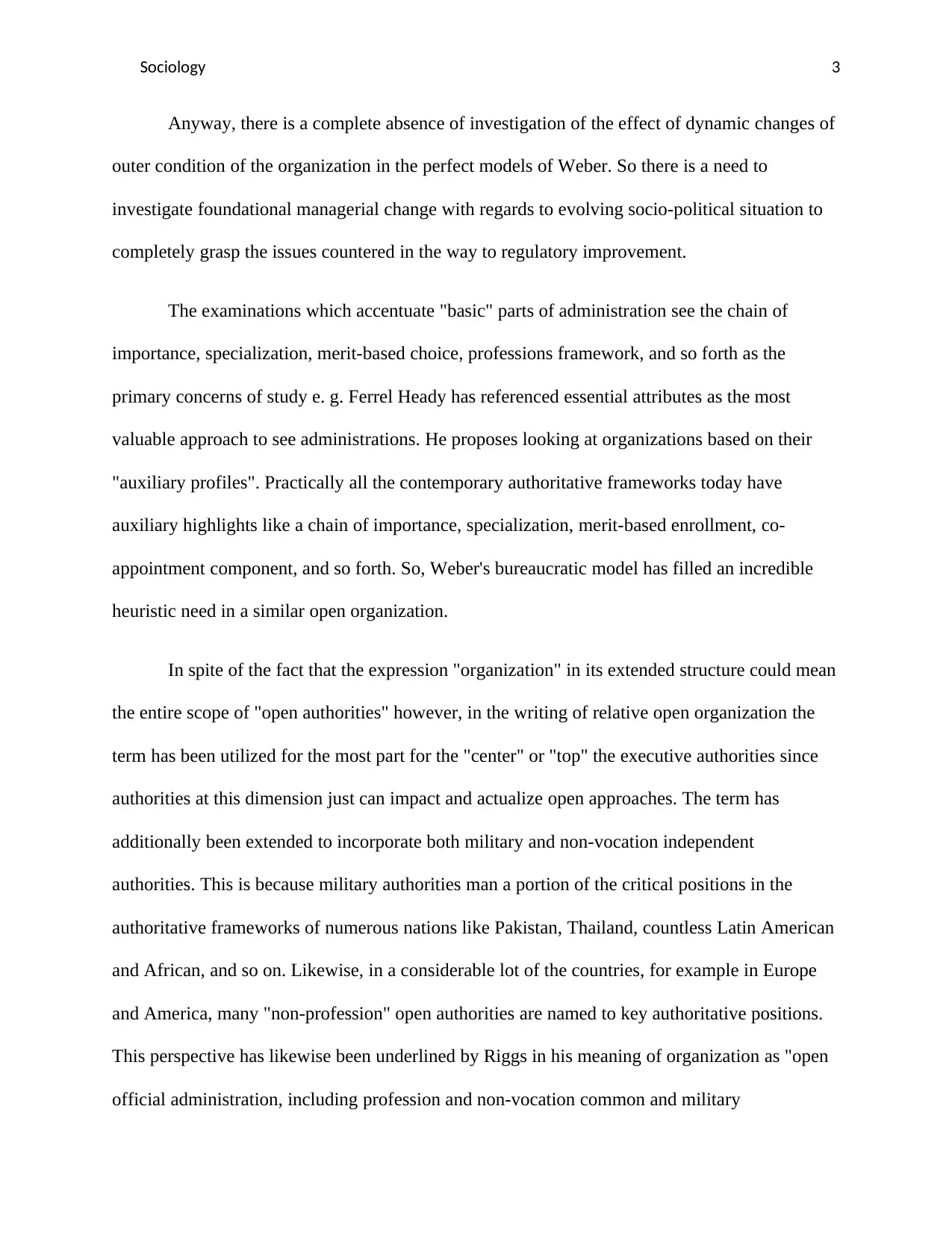
Sociology 3
Anyway, there is a complete absence of investigation of the effect of dynamic changes of
outer condition of the organization in the perfect models of Weber. So there is a need to
investigate foundational managerial change with regards to evolving socio-political situation to
completely grasp the issues countered in the way to regulatory improvement.
The examinations which accentuate "basic" parts of administration see the chain of
importance, specialization, merit-based choice, professions framework, and so forth as the
primary concerns of study e. g. Ferrel Heady has referenced essential attributes as the most
valuable approach to see administrations. He proposes looking at organizations based on their
"auxiliary profiles". Practically all the contemporary authoritative frameworks today have
auxiliary highlights like a chain of importance, specialization, merit-based enrollment, co-
appointment component, and so forth. So, Weber's bureaucratic model has filled an incredible
heuristic need in a similar open organization.
In spite of the fact that the expression "organization" in its extended structure could mean
the entire scope of "open authorities" however, in the writing of relative open organization the
term has been utilized for the most part for the "center" or "top" the executive authorities since
authorities at this dimension just can impact and actualize open approaches. The term has
additionally been extended to incorporate both military and non-vocation independent
authorities. This is because military authorities man a portion of the critical positions in the
authoritative frameworks of numerous nations like Pakistan, Thailand, countless Latin American
and African, and so on. Likewise, in a considerable lot of the countries, for example in Europe
and America, many "non-profession" open authorities are named to key authoritative positions.
This perspective has likewise been underlined by Riggs in his meaning of organization as "open
official administration, including profession and non-vocation common and military
Anyway, there is a complete absence of investigation of the effect of dynamic changes of
outer condition of the organization in the perfect models of Weber. So there is a need to
investigate foundational managerial change with regards to evolving socio-political situation to
completely grasp the issues countered in the way to regulatory improvement.
The examinations which accentuate "basic" parts of administration see the chain of
importance, specialization, merit-based choice, professions framework, and so forth as the
primary concerns of study e. g. Ferrel Heady has referenced essential attributes as the most
valuable approach to see administrations. He proposes looking at organizations based on their
"auxiliary profiles". Practically all the contemporary authoritative frameworks today have
auxiliary highlights like a chain of importance, specialization, merit-based enrollment, co-
appointment component, and so forth. So, Weber's bureaucratic model has filled an incredible
heuristic need in a similar open organization.
In spite of the fact that the expression "organization" in its extended structure could mean
the entire scope of "open authorities" however, in the writing of relative open organization the
term has been utilized for the most part for the "center" or "top" the executive authorities since
authorities at this dimension just can impact and actualize open approaches. The term has
additionally been extended to incorporate both military and non-vocation independent
authorities. This is because military authorities man a portion of the critical positions in the
authoritative frameworks of numerous nations like Pakistan, Thailand, countless Latin American
and African, and so on. Likewise, in a considerable lot of the countries, for example in Europe
and America, many "non-profession" open authorities are named to key authoritative positions.
This perspective has likewise been underlined by Riggs in his meaning of organization as "open
official administration, including profession and non-vocation common and military
Paraphrase This Document
Need a fresh take? Get an instant paraphrase of this document with our AI Paraphraser
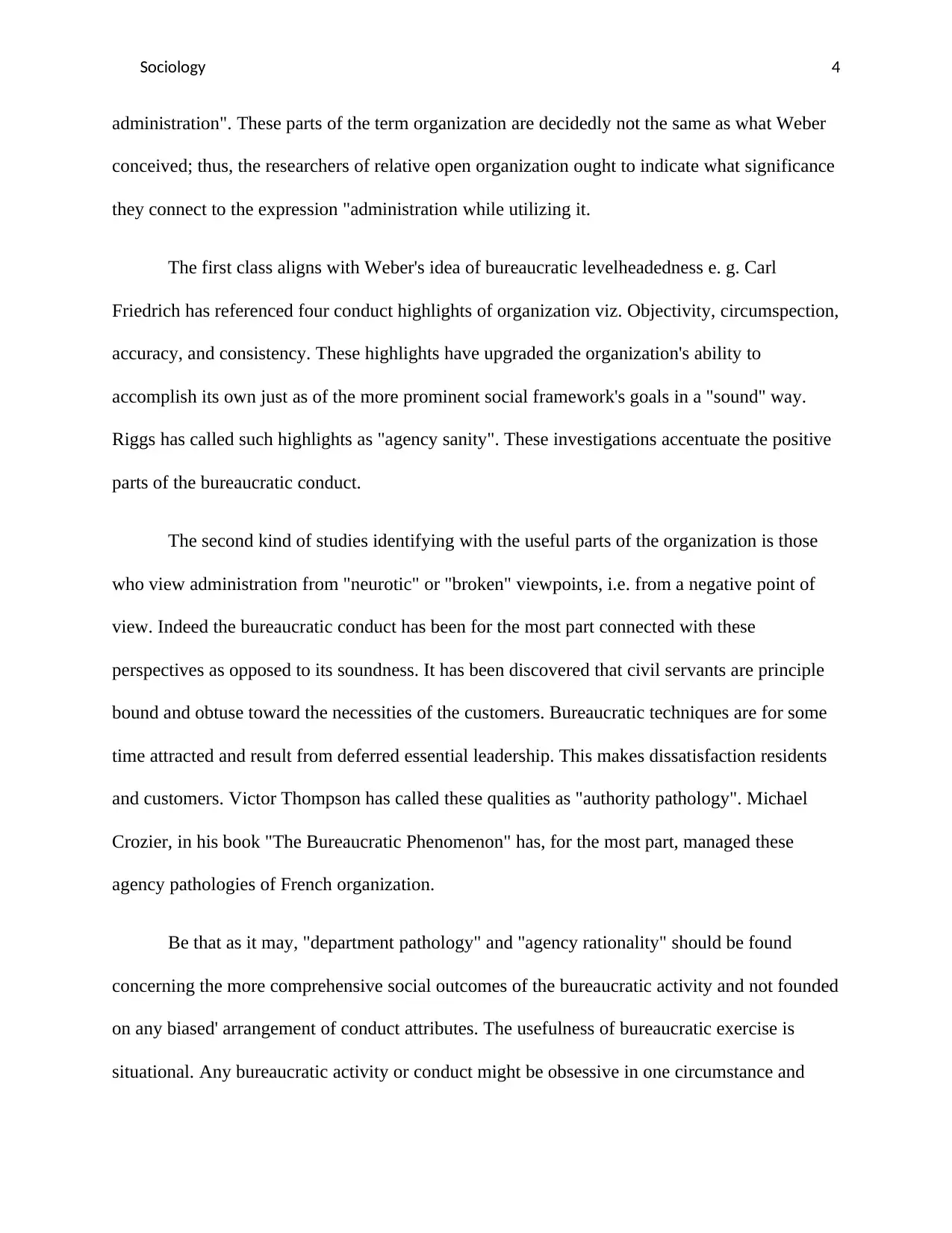
Sociology 4
administration". These parts of the term organization are decidedly not the same as what Weber
conceived; thus, the researchers of relative open organization ought to indicate what significance
they connect to the expression "administration while utilizing it.
The first class aligns with Weber's idea of bureaucratic levelheadedness e. g. Carl
Friedrich has referenced four conduct highlights of organization viz. Objectivity, circumspection,
accuracy, and consistency. These highlights have upgraded the organization's ability to
accomplish its own just as of the more prominent social framework's goals in a "sound" way.
Riggs has called such highlights as "agency sanity". These investigations accentuate the positive
parts of the bureaucratic conduct.
The second kind of studies identifying with the useful parts of the organization is those
who view administration from "neurotic" or "broken" viewpoints, i.e. from a negative point of
view. Indeed the bureaucratic conduct has been for the most part connected with these
perspectives as opposed to its soundness. It has been discovered that civil servants are principle
bound and obtuse toward the necessities of the customers. Bureaucratic techniques are for some
time attracted and result from deferred essential leadership. This makes dissatisfaction residents
and customers. Victor Thompson has called these qualities as "authority pathology". Michael
Crozier, in his book "The Bureaucratic Phenomenon" has, for the most part, managed these
agency pathologies of French organization.
Be that as it may, "department pathology" and "agency rationality" should be found
concerning the more comprehensive social outcomes of the bureaucratic activity and not founded
on any biased' arrangement of conduct attributes. The usefulness of bureaucratic exercise is
situational. Any bureaucratic activity or conduct might be obsessive in one circumstance and
administration". These parts of the term organization are decidedly not the same as what Weber
conceived; thus, the researchers of relative open organization ought to indicate what significance
they connect to the expression "administration while utilizing it.
The first class aligns with Weber's idea of bureaucratic levelheadedness e. g. Carl
Friedrich has referenced four conduct highlights of organization viz. Objectivity, circumspection,
accuracy, and consistency. These highlights have upgraded the organization's ability to
accomplish its own just as of the more prominent social framework's goals in a "sound" way.
Riggs has called such highlights as "agency sanity". These investigations accentuate the positive
parts of the bureaucratic conduct.
The second kind of studies identifying with the useful parts of the organization is those
who view administration from "neurotic" or "broken" viewpoints, i.e. from a negative point of
view. Indeed the bureaucratic conduct has been for the most part connected with these
perspectives as opposed to its soundness. It has been discovered that civil servants are principle
bound and obtuse toward the necessities of the customers. Bureaucratic techniques are for some
time attracted and result from deferred essential leadership. This makes dissatisfaction residents
and customers. Victor Thompson has called these qualities as "authority pathology". Michael
Crozier, in his book "The Bureaucratic Phenomenon" has, for the most part, managed these
agency pathologies of French organization.
Be that as it may, "department pathology" and "agency rationality" should be found
concerning the more comprehensive social outcomes of the bureaucratic activity and not founded
on any biased' arrangement of conduct attributes. The usefulness of bureaucratic exercise is
situational. Any bureaucratic activity or conduct might be obsessive in one circumstance and
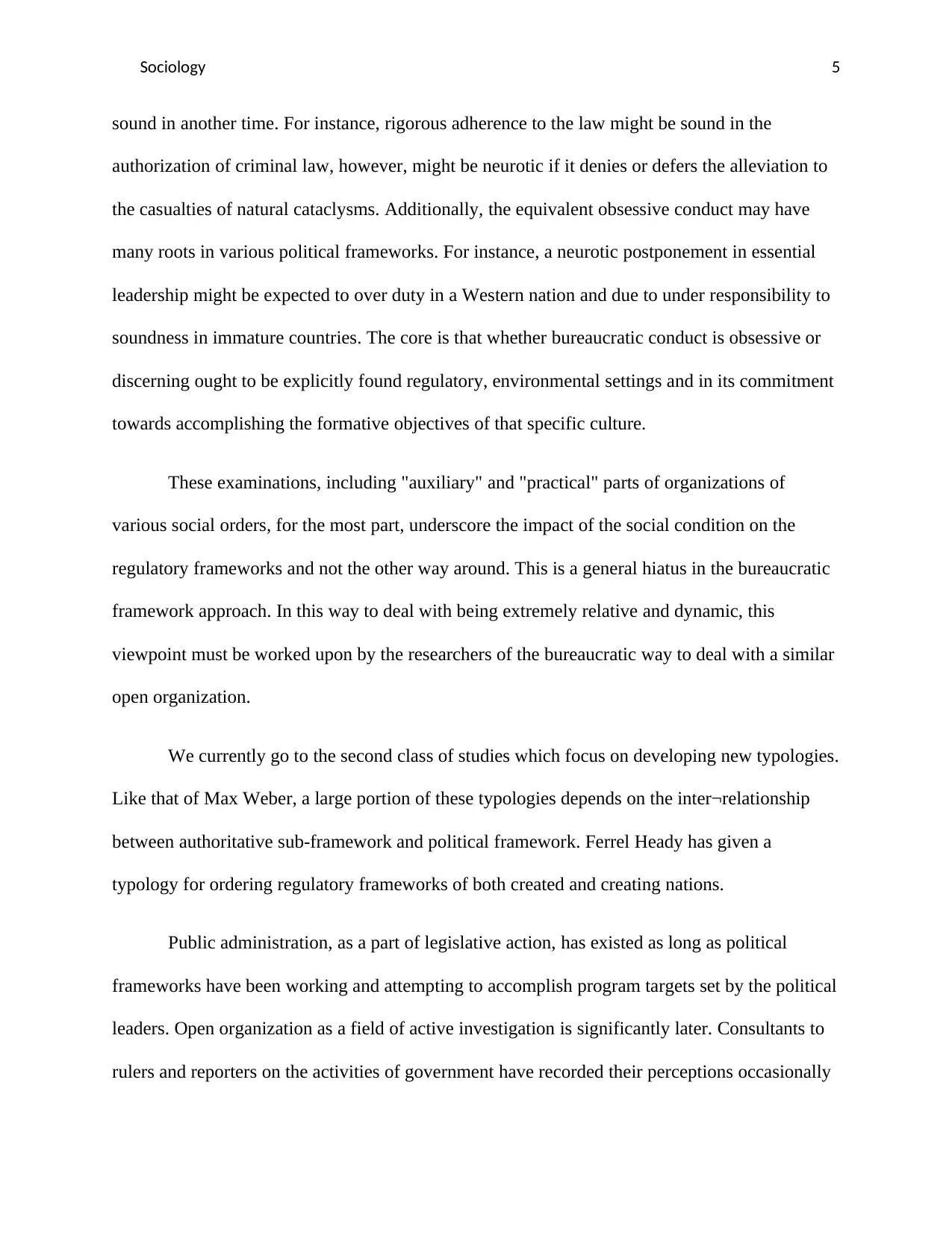
Sociology 5
sound in another time. For instance, rigorous adherence to the law might be sound in the
authorization of criminal law, however, might be neurotic if it denies or defers the alleviation to
the casualties of natural cataclysms. Additionally, the equivalent obsessive conduct may have
many roots in various political frameworks. For instance, a neurotic postponement in essential
leadership might be expected to over duty in a Western nation and due to under responsibility to
soundness in immature countries. The core is that whether bureaucratic conduct is obsessive or
discerning ought to be explicitly found regulatory, environmental settings and in its commitment
towards accomplishing the formative objectives of that specific culture.
These examinations, including "auxiliary" and "practical" parts of organizations of
various social orders, for the most part, underscore the impact of the social condition on the
regulatory frameworks and not the other way around. This is a general hiatus in the bureaucratic
framework approach. In this way to deal with being extremely relative and dynamic, this
viewpoint must be worked upon by the researchers of the bureaucratic way to deal with a similar
open organization.
We currently go to the second class of studies which focus on developing new typologies.
Like that of Max Weber, a large portion of these typologies depends on the inter¬relationship
between authoritative sub-framework and political framework. Ferrel Heady has given a
typology for ordering regulatory frameworks of both created and creating nations.
Public administration, as a part of legislative action, has existed as long as political
frameworks have been working and attempting to accomplish program targets set by the political
leaders. Open organization as a field of active investigation is significantly later. Consultants to
rulers and reporters on the activities of government have recorded their perceptions occasionally
sound in another time. For instance, rigorous adherence to the law might be sound in the
authorization of criminal law, however, might be neurotic if it denies or defers the alleviation to
the casualties of natural cataclysms. Additionally, the equivalent obsessive conduct may have
many roots in various political frameworks. For instance, a neurotic postponement in essential
leadership might be expected to over duty in a Western nation and due to under responsibility to
soundness in immature countries. The core is that whether bureaucratic conduct is obsessive or
discerning ought to be explicitly found regulatory, environmental settings and in its commitment
towards accomplishing the formative objectives of that specific culture.
These examinations, including "auxiliary" and "practical" parts of organizations of
various social orders, for the most part, underscore the impact of the social condition on the
regulatory frameworks and not the other way around. This is a general hiatus in the bureaucratic
framework approach. In this way to deal with being extremely relative and dynamic, this
viewpoint must be worked upon by the researchers of the bureaucratic way to deal with a similar
open organization.
We currently go to the second class of studies which focus on developing new typologies.
Like that of Max Weber, a large portion of these typologies depends on the inter¬relationship
between authoritative sub-framework and political framework. Ferrel Heady has given a
typology for ordering regulatory frameworks of both created and creating nations.
Public administration, as a part of legislative action, has existed as long as political
frameworks have been working and attempting to accomplish program targets set by the political
leaders. Open organization as a field of active investigation is significantly later. Consultants to
rulers and reporters on the activities of government have recorded their perceptions occasionally
⊘ This is a preview!⊘
Do you want full access?
Subscribe today to unlock all pages.

Trusted by 1+ million students worldwide
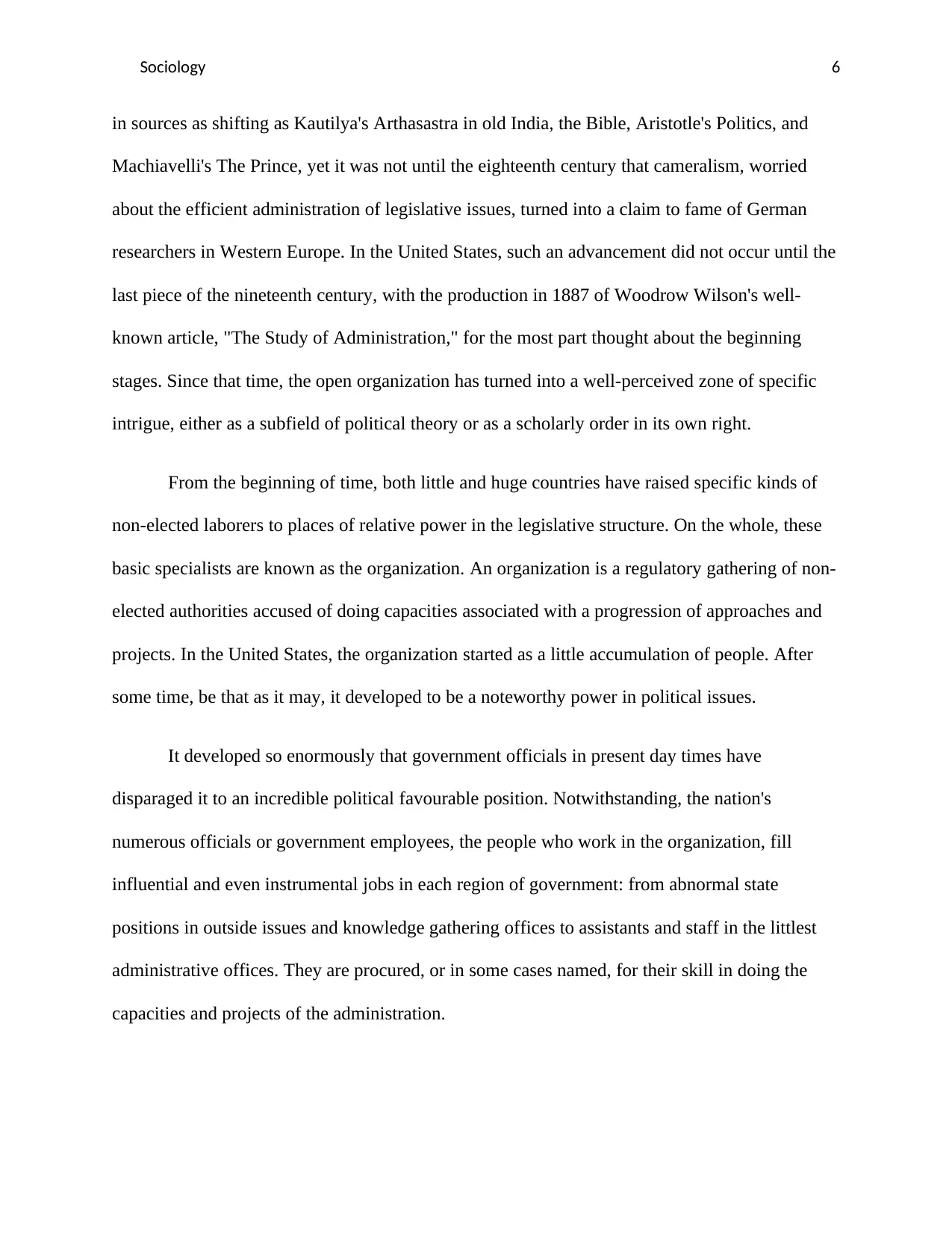
Sociology 6
in sources as shifting as Kautilya's Arthasastra in old India, the Bible, Aristotle's Politics, and
Machiavelli's The Prince, yet it was not until the eighteenth century that cameralism, worried
about the efficient administration of legislative issues, turned into a claim to fame of German
researchers in Western Europe. In the United States, such an advancement did not occur until the
last piece of the nineteenth century, with the production in 1887 of Woodrow Wilson's well-
known article, "The Study of Administration," for the most part thought about the beginning
stages. Since that time, the open organization has turned into a well-perceived zone of specific
intrigue, either as a subfield of political theory or as a scholarly order in its own right.
From the beginning of time, both little and huge countries have raised specific kinds of
non-elected laborers to places of relative power in the legislative structure. On the whole, these
basic specialists are known as the organization. An organization is a regulatory gathering of non-
elected authorities accused of doing capacities associated with a progression of approaches and
projects. In the United States, the organization started as a little accumulation of people. After
some time, be that as it may, it developed to be a noteworthy power in political issues.
It developed so enormously that government officials in present day times have
disparaged it to an incredible political favourable position. Notwithstanding, the nation's
numerous officials or government employees, the people who work in the organization, fill
influential and even instrumental jobs in each region of government: from abnormal state
positions in outside issues and knowledge gathering offices to assistants and staff in the littlest
administrative offices. They are procured, or in some cases named, for their skill in doing the
capacities and projects of the administration.
in sources as shifting as Kautilya's Arthasastra in old India, the Bible, Aristotle's Politics, and
Machiavelli's The Prince, yet it was not until the eighteenth century that cameralism, worried
about the efficient administration of legislative issues, turned into a claim to fame of German
researchers in Western Europe. In the United States, such an advancement did not occur until the
last piece of the nineteenth century, with the production in 1887 of Woodrow Wilson's well-
known article, "The Study of Administration," for the most part thought about the beginning
stages. Since that time, the open organization has turned into a well-perceived zone of specific
intrigue, either as a subfield of political theory or as a scholarly order in its own right.
From the beginning of time, both little and huge countries have raised specific kinds of
non-elected laborers to places of relative power in the legislative structure. On the whole, these
basic specialists are known as the organization. An organization is a regulatory gathering of non-
elected authorities accused of doing capacities associated with a progression of approaches and
projects. In the United States, the organization started as a little accumulation of people. After
some time, be that as it may, it developed to be a noteworthy power in political issues.
It developed so enormously that government officials in present day times have
disparaged it to an incredible political favourable position. Notwithstanding, the nation's
numerous officials or government employees, the people who work in the organization, fill
influential and even instrumental jobs in each region of government: from abnormal state
positions in outside issues and knowledge gathering offices to assistants and staff in the littlest
administrative offices. They are procured, or in some cases named, for their skill in doing the
capacities and projects of the administration.
Paraphrase This Document
Need a fresh take? Get an instant paraphrase of this document with our AI Paraphraser
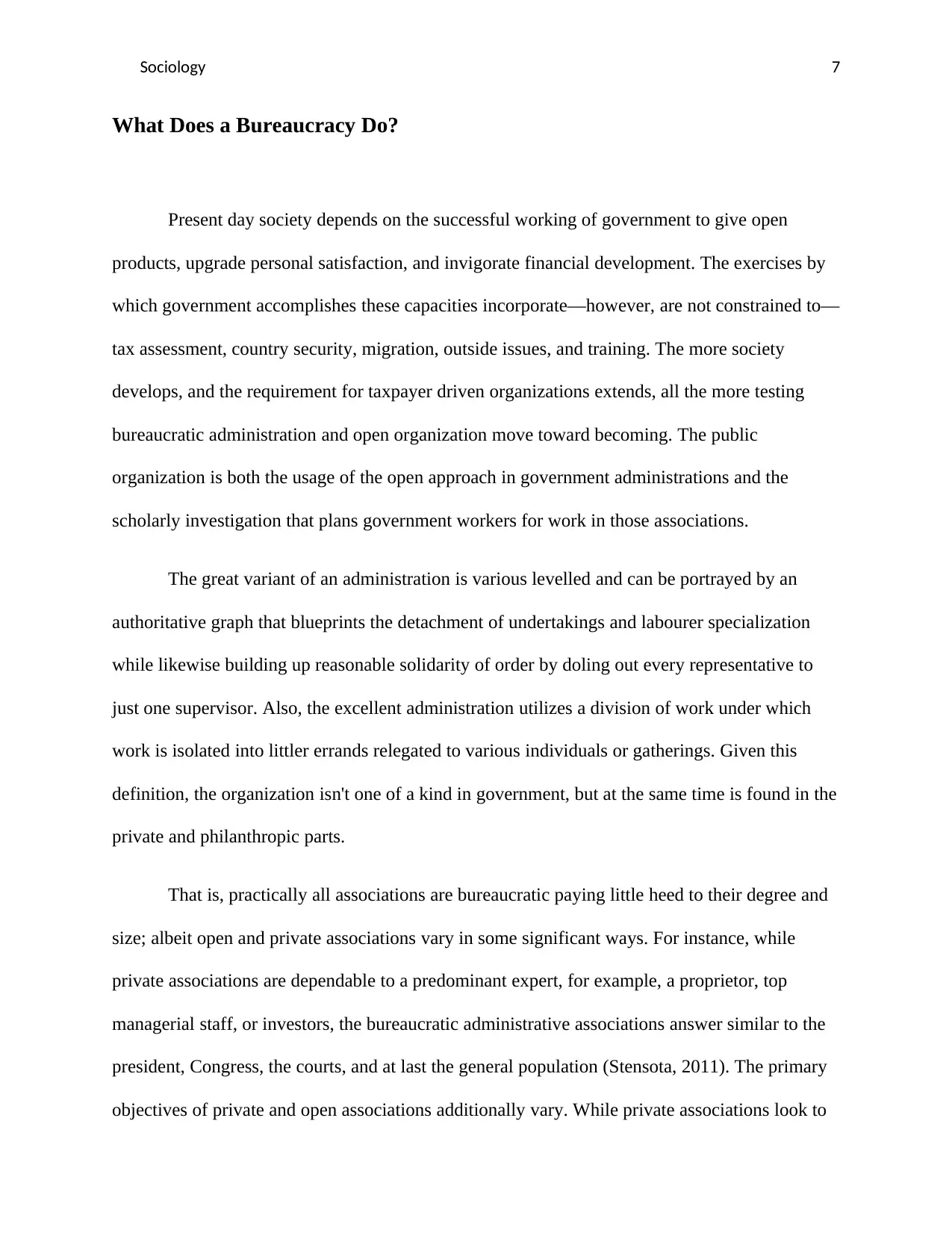
Sociology 7
What Does a Bureaucracy Do?
Present day society depends on the successful working of government to give open
products, upgrade personal satisfaction, and invigorate financial development. The exercises by
which government accomplishes these capacities incorporate—however, are not constrained to—
tax assessment, country security, migration, outside issues, and training. The more society
develops, and the requirement for taxpayer driven organizations extends, all the more testing
bureaucratic administration and open organization move toward becoming. The public
organization is both the usage of the open approach in government administrations and the
scholarly investigation that plans government workers for work in those associations.
The great variant of an administration is various levelled and can be portrayed by an
authoritative graph that blueprints the detachment of undertakings and labourer specialization
while likewise building up reasonable solidarity of order by doling out every representative to
just one supervisor. Also, the excellent administration utilizes a division of work under which
work is isolated into littler errands relegated to various individuals or gatherings. Given this
definition, the organization isn't one of a kind in government, but at the same time is found in the
private and philanthropic parts.
That is, practically all associations are bureaucratic paying little heed to their degree and
size; albeit open and private associations vary in some significant ways. For instance, while
private associations are dependable to a predominant expert, for example, a proprietor, top
managerial staff, or investors, the bureaucratic administrative associations answer similar to the
president, Congress, the courts, and at last the general population (Stensota, 2011). The primary
objectives of private and open associations additionally vary. While private associations look to
What Does a Bureaucracy Do?
Present day society depends on the successful working of government to give open
products, upgrade personal satisfaction, and invigorate financial development. The exercises by
which government accomplishes these capacities incorporate—however, are not constrained to—
tax assessment, country security, migration, outside issues, and training. The more society
develops, and the requirement for taxpayer driven organizations extends, all the more testing
bureaucratic administration and open organization move toward becoming. The public
organization is both the usage of the open approach in government administrations and the
scholarly investigation that plans government workers for work in those associations.
The great variant of an administration is various levelled and can be portrayed by an
authoritative graph that blueprints the detachment of undertakings and labourer specialization
while likewise building up reasonable solidarity of order by doling out every representative to
just one supervisor. Also, the excellent administration utilizes a division of work under which
work is isolated into littler errands relegated to various individuals or gatherings. Given this
definition, the organization isn't one of a kind in government, but at the same time is found in the
private and philanthropic parts.
That is, practically all associations are bureaucratic paying little heed to their degree and
size; albeit open and private associations vary in some significant ways. For instance, while
private associations are dependable to a predominant expert, for example, a proprietor, top
managerial staff, or investors, the bureaucratic administrative associations answer similar to the
president, Congress, the courts, and at last the general population (Stensota, 2011). The primary
objectives of private and open associations additionally vary. While private associations look to
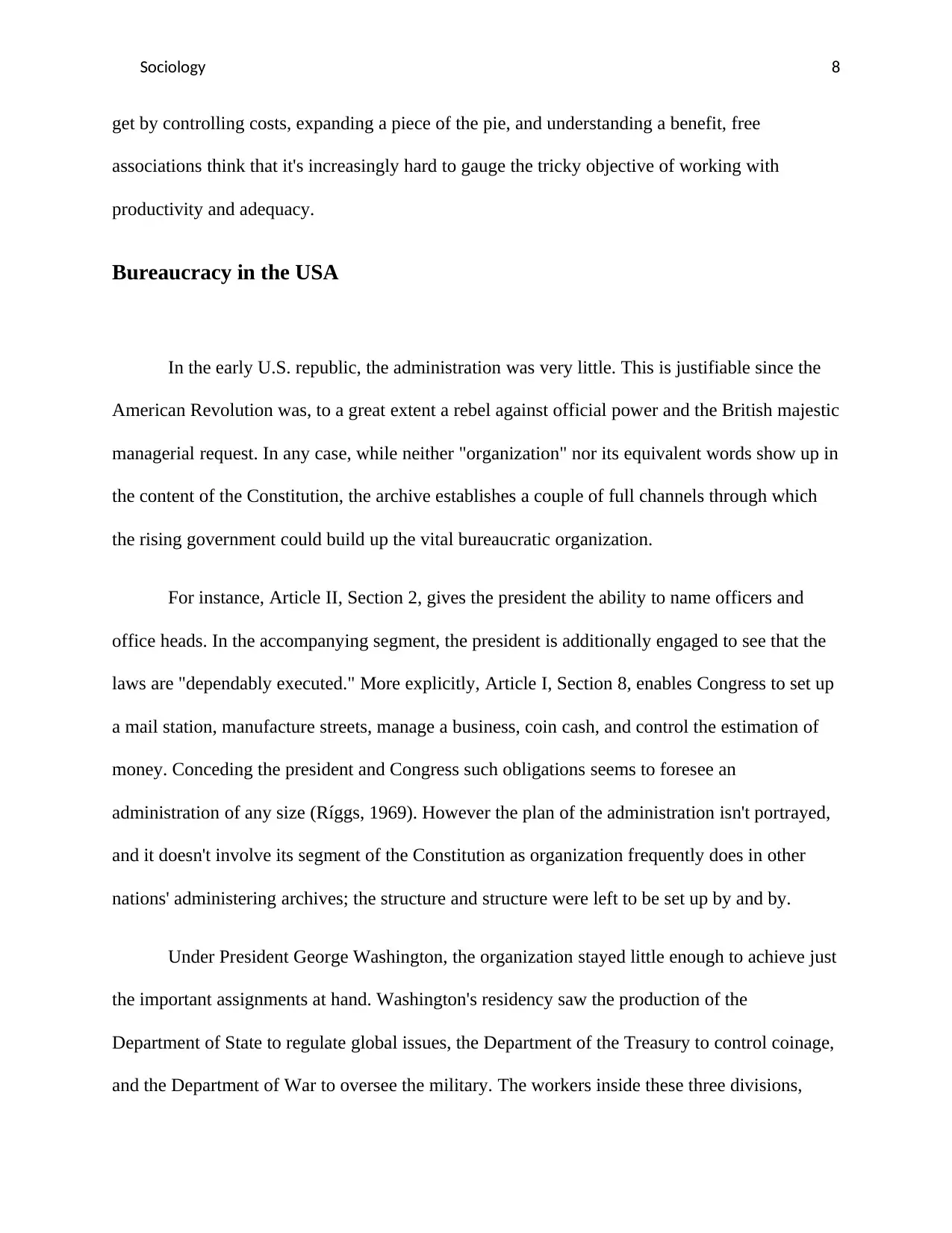
Sociology 8
get by controlling costs, expanding a piece of the pie, and understanding a benefit, free
associations think that it's increasingly hard to gauge the tricky objective of working with
productivity and adequacy.
Bureaucracy in the USA
In the early U.S. republic, the administration was very little. This is justifiable since the
American Revolution was, to a great extent a rebel against official power and the British majestic
managerial request. In any case, while neither "organization" nor its equivalent words show up in
the content of the Constitution, the archive establishes a couple of full channels through which
the rising government could build up the vital bureaucratic organization.
For instance, Article II, Section 2, gives the president the ability to name officers and
office heads. In the accompanying segment, the president is additionally engaged to see that the
laws are "dependably executed." More explicitly, Article I, Section 8, enables Congress to set up
a mail station, manufacture streets, manage a business, coin cash, and control the estimation of
money. Conceding the president and Congress such obligations seems to foresee an
administration of any size (Ríggs, 1969). However the plan of the administration isn't portrayed,
and it doesn't involve its segment of the Constitution as organization frequently does in other
nations' administering archives; the structure and structure were left to be set up by and by.
Under President George Washington, the organization stayed little enough to achieve just
the important assignments at hand. Washington's residency saw the production of the
Department of State to regulate global issues, the Department of the Treasury to control coinage,
and the Department of War to oversee the military. The workers inside these three divisions,
get by controlling costs, expanding a piece of the pie, and understanding a benefit, free
associations think that it's increasingly hard to gauge the tricky objective of working with
productivity and adequacy.
Bureaucracy in the USA
In the early U.S. republic, the administration was very little. This is justifiable since the
American Revolution was, to a great extent a rebel against official power and the British majestic
managerial request. In any case, while neither "organization" nor its equivalent words show up in
the content of the Constitution, the archive establishes a couple of full channels through which
the rising government could build up the vital bureaucratic organization.
For instance, Article II, Section 2, gives the president the ability to name officers and
office heads. In the accompanying segment, the president is additionally engaged to see that the
laws are "dependably executed." More explicitly, Article I, Section 8, enables Congress to set up
a mail station, manufacture streets, manage a business, coin cash, and control the estimation of
money. Conceding the president and Congress such obligations seems to foresee an
administration of any size (Ríggs, 1969). However the plan of the administration isn't portrayed,
and it doesn't involve its segment of the Constitution as organization frequently does in other
nations' administering archives; the structure and structure were left to be set up by and by.
Under President George Washington, the organization stayed little enough to achieve just
the important assignments at hand. Washington's residency saw the production of the
Department of State to regulate global issues, the Department of the Treasury to control coinage,
and the Department of War to oversee the military. The workers inside these three divisions,
⊘ This is a preview!⊘
Do you want full access?
Subscribe today to unlock all pages.

Trusted by 1+ million students worldwide
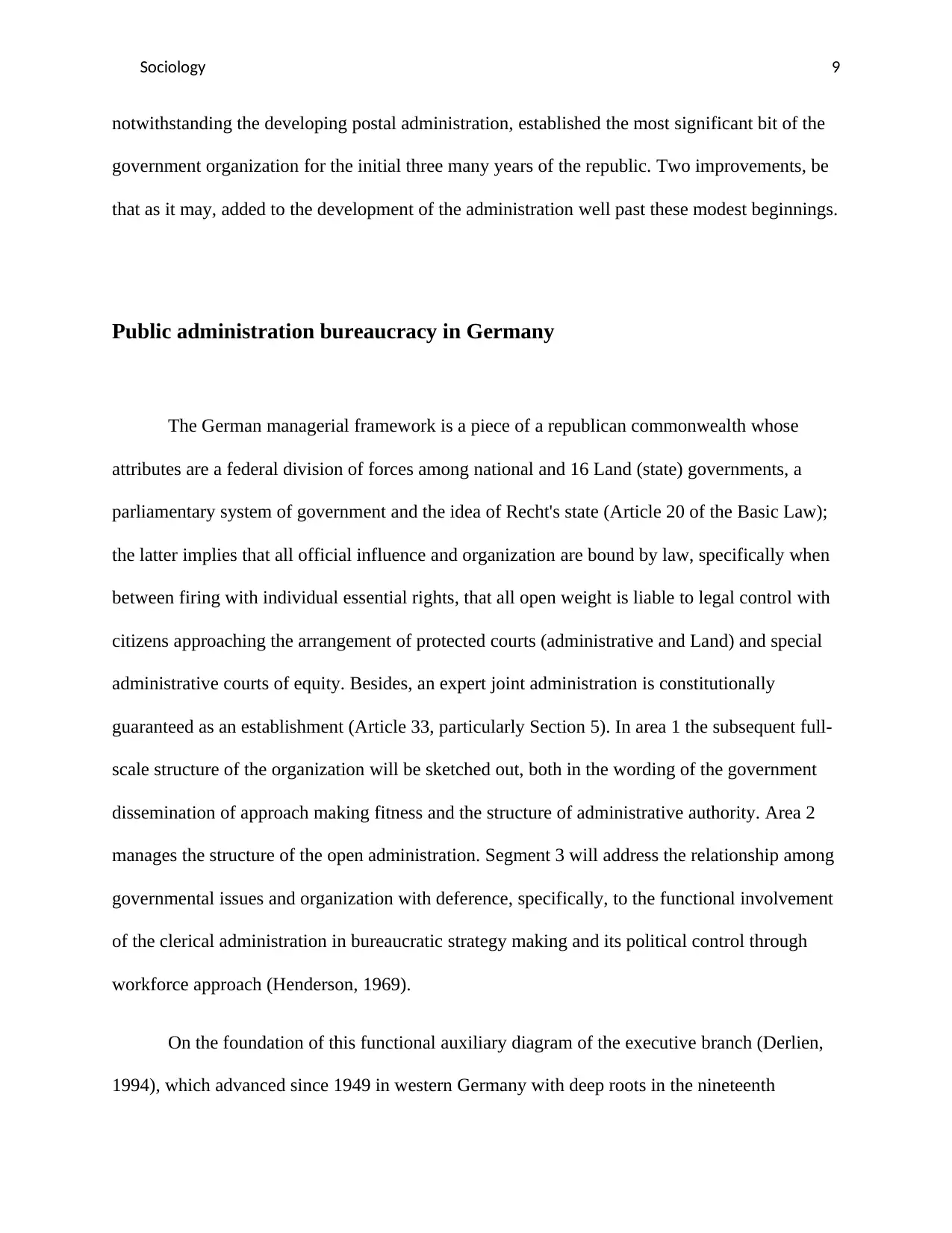
Sociology 9
notwithstanding the developing postal administration, established the most significant bit of the
government organization for the initial three many years of the republic. Two improvements, be
that as it may, added to the development of the administration well past these modest beginnings.
Public administration bureaucracy in Germany
The German managerial framework is a piece of a republican commonwealth whose
attributes are a federal division of forces among national and 16 Land (state) governments, a
parliamentary system of government and the idea of Recht's state (Article 20 of the Basic Law);
the latter implies that all official influence and organization are bound by law, specifically when
between firing with individual essential rights, that all open weight is liable to legal control with
citizens approaching the arrangement of protected courts (administrative and Land) and special
administrative courts of equity. Besides, an expert joint administration is constitutionally
guaranteed as an establishment (Article 33, particularly Section 5). In area 1 the subsequent full-
scale structure of the organization will be sketched out, both in the wording of the government
dissemination of approach making fitness and the structure of administrative authority. Area 2
manages the structure of the open administration. Segment 3 will address the relationship among
governmental issues and organization with deference, specifically, to the functional involvement
of the clerical administration in bureaucratic strategy making and its political control through
workforce approach (Henderson, 1969).
On the foundation of this functional auxiliary diagram of the executive branch (Derlien,
1994), which advanced since 1949 in western Germany with deep roots in the nineteenth
notwithstanding the developing postal administration, established the most significant bit of the
government organization for the initial three many years of the republic. Two improvements, be
that as it may, added to the development of the administration well past these modest beginnings.
Public administration bureaucracy in Germany
The German managerial framework is a piece of a republican commonwealth whose
attributes are a federal division of forces among national and 16 Land (state) governments, a
parliamentary system of government and the idea of Recht's state (Article 20 of the Basic Law);
the latter implies that all official influence and organization are bound by law, specifically when
between firing with individual essential rights, that all open weight is liable to legal control with
citizens approaching the arrangement of protected courts (administrative and Land) and special
administrative courts of equity. Besides, an expert joint administration is constitutionally
guaranteed as an establishment (Article 33, particularly Section 5). In area 1 the subsequent full-
scale structure of the organization will be sketched out, both in the wording of the government
dissemination of approach making fitness and the structure of administrative authority. Area 2
manages the structure of the open administration. Segment 3 will address the relationship among
governmental issues and organization with deference, specifically, to the functional involvement
of the clerical administration in bureaucratic strategy making and its political control through
workforce approach (Henderson, 1969).
On the foundation of this functional auxiliary diagram of the executive branch (Derlien,
1994), which advanced since 1949 in western Germany with deep roots in the nineteenth
Paraphrase This Document
Need a fresh take? Get an instant paraphrase of this document with our AI Paraphraser
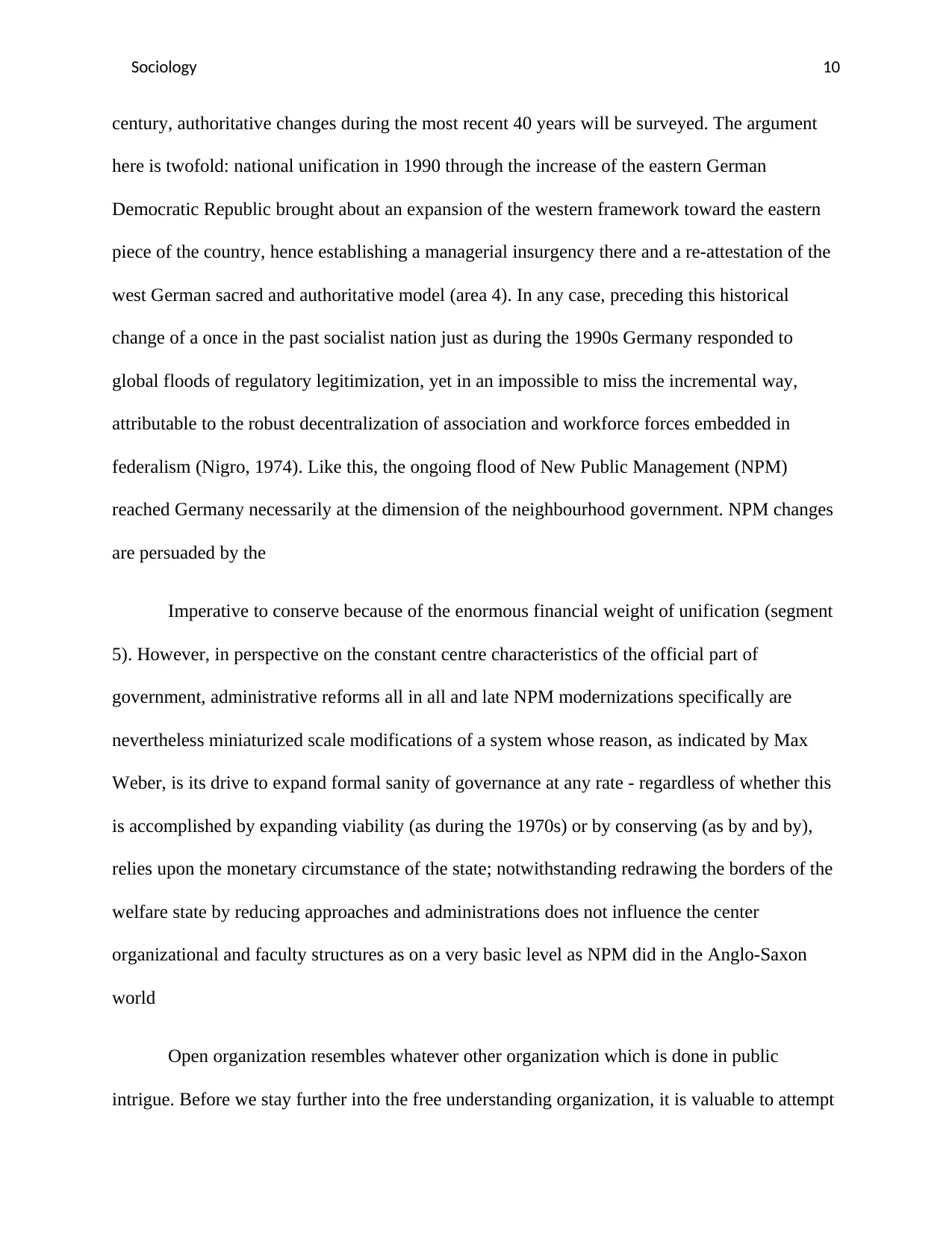
Sociology 10
century, authoritative changes during the most recent 40 years will be surveyed. The argument
here is twofold: national unification in 1990 through the increase of the eastern German
Democratic Republic brought about an expansion of the western framework toward the eastern
piece of the country, hence establishing a managerial insurgency there and a re-attestation of the
west German sacred and authoritative model (area 4). In any case, preceding this historical
change of a once in the past socialist nation just as during the 1990s Germany responded to
global floods of regulatory legitimization, yet in an impossible to miss the incremental way,
attributable to the robust decentralization of association and workforce forces embedded in
federalism (Nigro, 1974). Like this, the ongoing flood of New Public Management (NPM)
reached Germany necessarily at the dimension of the neighbourhood government. NPM changes
are persuaded by the
Imperative to conserve because of the enormous financial weight of unification (segment
5). However, in perspective on the constant centre characteristics of the official part of
government, administrative reforms all in all and late NPM modernizations specifically are
nevertheless miniaturized scale modifications of a system whose reason, as indicated by Max
Weber, is its drive to expand formal sanity of governance at any rate - regardless of whether this
is accomplished by expanding viability (as during the 1970s) or by conserving (as by and by),
relies upon the monetary circumstance of the state; notwithstanding redrawing the borders of the
welfare state by reducing approaches and administrations does not influence the center
organizational and faculty structures as on a very basic level as NPM did in the Anglo-Saxon
world
Open organization resembles whatever other organization which is done in public
intrigue. Before we stay further into the free understanding organization, it is valuable to attempt
century, authoritative changes during the most recent 40 years will be surveyed. The argument
here is twofold: national unification in 1990 through the increase of the eastern German
Democratic Republic brought about an expansion of the western framework toward the eastern
piece of the country, hence establishing a managerial insurgency there and a re-attestation of the
west German sacred and authoritative model (area 4). In any case, preceding this historical
change of a once in the past socialist nation just as during the 1990s Germany responded to
global floods of regulatory legitimization, yet in an impossible to miss the incremental way,
attributable to the robust decentralization of association and workforce forces embedded in
federalism (Nigro, 1974). Like this, the ongoing flood of New Public Management (NPM)
reached Germany necessarily at the dimension of the neighbourhood government. NPM changes
are persuaded by the
Imperative to conserve because of the enormous financial weight of unification (segment
5). However, in perspective on the constant centre characteristics of the official part of
government, administrative reforms all in all and late NPM modernizations specifically are
nevertheless miniaturized scale modifications of a system whose reason, as indicated by Max
Weber, is its drive to expand formal sanity of governance at any rate - regardless of whether this
is accomplished by expanding viability (as during the 1970s) or by conserving (as by and by),
relies upon the monetary circumstance of the state; notwithstanding redrawing the borders of the
welfare state by reducing approaches and administrations does not influence the center
organizational and faculty structures as on a very basic level as NPM did in the Anglo-Saxon
world
Open organization resembles whatever other organization which is done in public
intrigue. Before we stay further into the free understanding organization, it is valuable to attempt
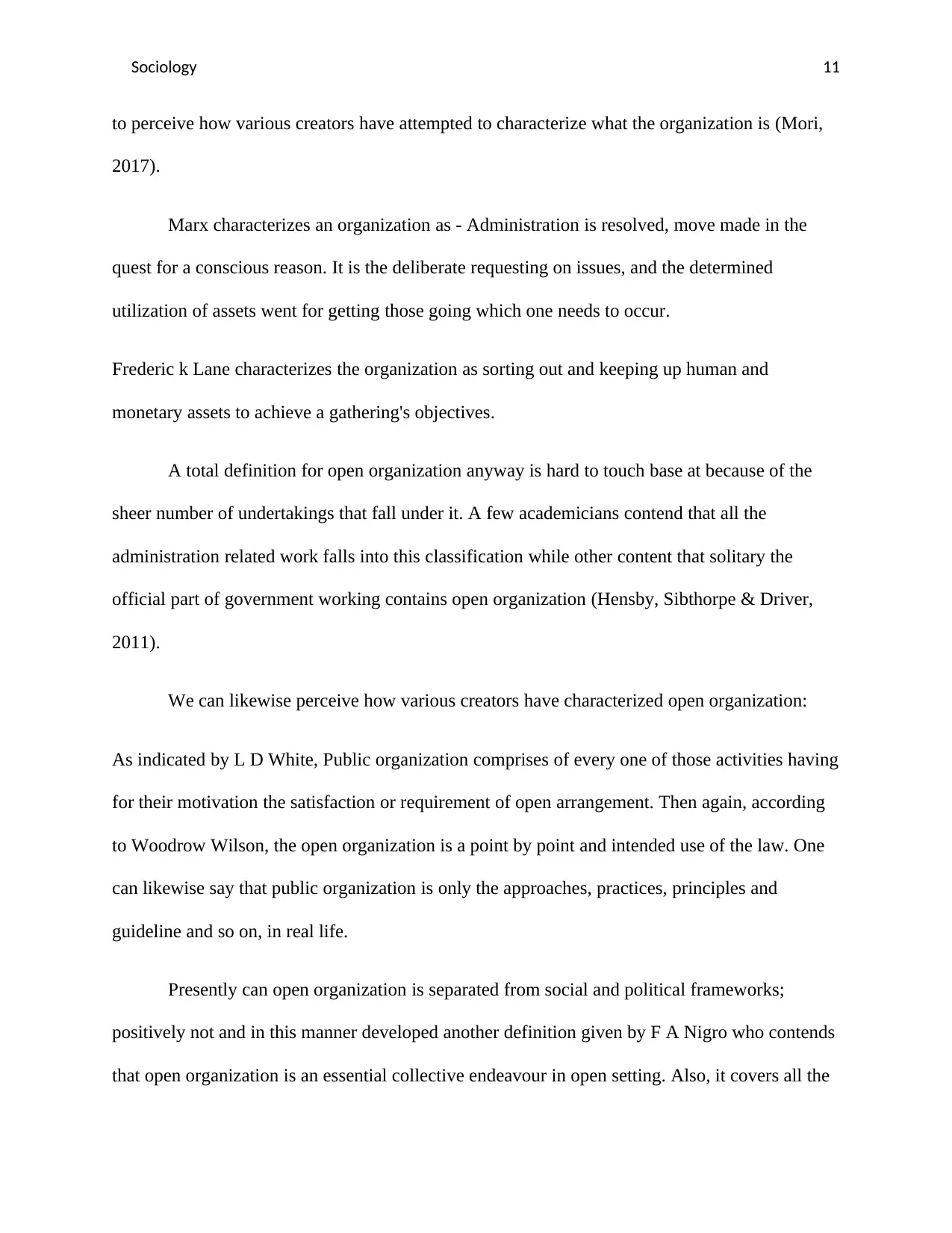
Sociology 11
to perceive how various creators have attempted to characterize what the organization is (Mori,
2017).
Marx characterizes an organization as - Administration is resolved, move made in the
quest for a conscious reason. It is the deliberate requesting on issues, and the determined
utilization of assets went for getting those going which one needs to occur.
Frederic k Lane characterizes the organization as sorting out and keeping up human and
monetary assets to achieve a gathering's objectives.
A total definition for open organization anyway is hard to touch base at because of the
sheer number of undertakings that fall under it. A few academicians contend that all the
administration related work falls into this classification while other content that solitary the
official part of government working contains open organization (Hensby, Sibthorpe & Driver,
2011).
We can likewise perceive how various creators have characterized open organization:
As indicated by L D White, Public organization comprises of every one of those activities having
for their motivation the satisfaction or requirement of open arrangement. Then again, according
to Woodrow Wilson, the open organization is a point by point and intended use of the law. One
can likewise say that public organization is only the approaches, practices, principles and
guideline and so on, in real life.
Presently can open organization is separated from social and political frameworks;
positively not and in this manner developed another definition given by F A Nigro who contends
that open organization is an essential collective endeavour in open setting. Also, it covers all the
to perceive how various creators have attempted to characterize what the organization is (Mori,
2017).
Marx characterizes an organization as - Administration is resolved, move made in the
quest for a conscious reason. It is the deliberate requesting on issues, and the determined
utilization of assets went for getting those going which one needs to occur.
Frederic k Lane characterizes the organization as sorting out and keeping up human and
monetary assets to achieve a gathering's objectives.
A total definition for open organization anyway is hard to touch base at because of the
sheer number of undertakings that fall under it. A few academicians contend that all the
administration related work falls into this classification while other content that solitary the
official part of government working contains open organization (Hensby, Sibthorpe & Driver,
2011).
We can likewise perceive how various creators have characterized open organization:
As indicated by L D White, Public organization comprises of every one of those activities having
for their motivation the satisfaction or requirement of open arrangement. Then again, according
to Woodrow Wilson, the open organization is a point by point and intended use of the law. One
can likewise say that public organization is only the approaches, practices, principles and
guideline and so on, in real life.
Presently can open organization is separated from social and political frameworks;
positively not and in this manner developed another definition given by F A Nigro who contends
that open organization is an essential collective endeavour in open setting. Also, it covers all the
⊘ This is a preview!⊘
Do you want full access?
Subscribe today to unlock all pages.

Trusted by 1+ million students worldwide
1 out of 17
Your All-in-One AI-Powered Toolkit for Academic Success.
+13062052269
info@desklib.com
Available 24*7 on WhatsApp / Email
![[object Object]](/_next/static/media/star-bottom.7253800d.svg)
Unlock your academic potential
Copyright © 2020–2025 A2Z Services. All Rights Reserved. Developed and managed by ZUCOL.
